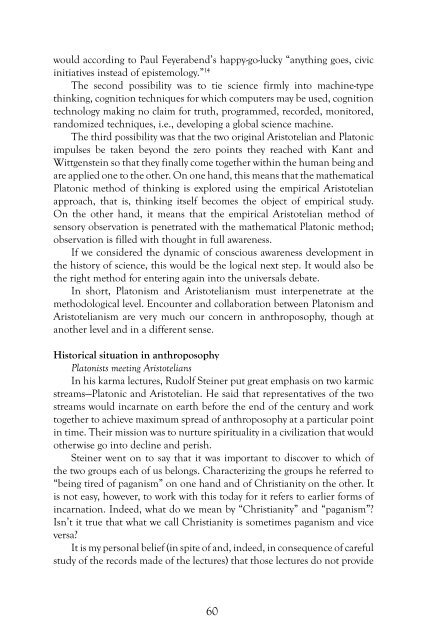When Healing Becomes Educating, Vol. 1 - Waldorf Research Institute
When Healing Becomes Educating, Vol. 1 - Waldorf Research Institute
When Healing Becomes Educating, Vol. 1 - Waldorf Research Institute
Create successful ePaper yourself
Turn your PDF publications into a flip-book with our unique Google optimized e-Paper software.
would according to Paul Feyerabend’s happy-go-lucky “anything goes, civic<br />
initiatives instead of epistemology.” 14<br />
The second possibility was to tie science firmly into machine-type<br />
thinking, cognition techniques for which computers may be used, cognition<br />
technology making no claim for truth, programmed, recorded, monitored,<br />
randomized techniques, i.e., developing a global science machine.<br />
The third possibility was that the two original Aristotelian and Platonic<br />
impulses be taken beyond the zero points they reached with Kant and<br />
Wittgenstein so that they finally come together within the human being and<br />
are applied one to the other. On one hand, this means that the mathematical<br />
Platonic method of thinking is explored using the empirical Aristotelian<br />
approach, that is, thinking itself becomes the object of empirical study.<br />
On the other hand, it means that the empirical Aristotelian method of<br />
sensory observation is penetrated with the mathematical Platonic method;<br />
observation is filled with thought in full awareness.<br />
If we considered the dynamic of conscious awareness development in<br />
the history of science, this would be the logical next step. It would also be<br />
the right method for entering again into the universals debate.<br />
In short, Platonism and Aristotelianism must interpenetrate at the<br />
methodological level. Encounter and collaboration between Platonism and<br />
Aristotelianism are very much our concern in anthroposophy, though at<br />
another level and in a different sense.<br />
Historical situation in anthroposophy<br />
Platonists meeting Aristotelians<br />
In his karma lectures, Rudolf Steiner put great emphasis on two karmic<br />
streams—Platonic and Aristotelian. He said that representatives of the two<br />
streams would incarnate on earth before the end of the century and work<br />
together to achieve maximum spread of anthroposophy at a particular point<br />
in time. Their mission was to nurture spirituality in a civilization that would<br />
otherwise go into decline and perish.<br />
Steiner went on to say that it was important to discover to which of<br />
the two groups each of us belongs. Characterizing the groups he referred to<br />
“being tired of paganism” on one hand and of Christianity on the other. It<br />
is not easy, however, to work with this today for it refers to earlier forms of<br />
incarnation. Indeed, what do we mean by “Christianity” and “paganism”?<br />
Isn’t it true that what we call Christianity is sometimes paganism and vice<br />
versa?<br />
It is my personal belief (in spite of and, indeed, in consequence of careful<br />
study of the records made of the lectures) that those lectures do not provide<br />
60

















